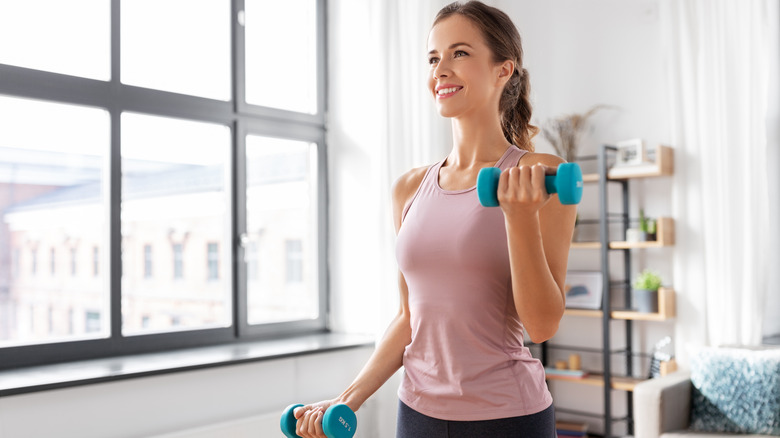Hammer Curls Vs. Bicep Curls: Which Is The Better Workout?
Have you ever had a fitness goal but can't seem to figure out the best way it can be achieved? Undoubtedly, building muscle takes time and can take up to four weeks before seeing an inkling of results (via Insider). It's not hard to see that arm workouts generally prove to be both challenging and effective at muscle growth when hitting the gym.
Specifically, trainers commonly recommend hammer curls and bicep curls for strengthening arm muscles. Plus, according to a 2018 study, it doesn't hurt that despite the older we get, an arm workout like bicep curls has the potential to improve brain function while increasing muscle growth (via PLoS One, posted at the National Library of Medicine). Exactly which exercise is better depends on your individual fitness end game: Are you hoping to get into shape for a specific event, sharpen up your present physical health, or hoping to maintain a total lifestyle change?
Bicep curls are the fundamental building blocks for workout variations like hammer curls
The key to upgrading your at-home workouts is finding exercises that work for you. For those hoping to score serious gains, bicep curls are by far the superior technique. By targeting muscles like the brachioradialis and toning the shoulders and back, bicep curls can change up the appearance of the upper body (via The Nest). The best part is that they don't require a huge learning curve — they're easier to master than a lot of other arm workouts (via In Motion O.C.). Per ClassPass, the best way to do this is to stand with arms bent at the waist and forearms facing up, then flex at the elbow to lift it while holding a dumbbell.
On the other hand, hammer curls are a type of bicep curl variation. What makes them valuable is they work the biceps, forearms, improve grip during challenging lifts, and can make it easier to grab heavy objects throughout the day (via Byrdie). The website also notes that it's crucial to have controlled elbows and shoulders to avoid harm to the body. Using a dumbbell, stand with knees together, slightly bent, and raise the arms so that the dumbbells are shoulder height with palms turned inward (via Very Well Fit).
Regardless of which workout you opt for, always remember that maintaining proper form and consulting a provider before starting a new routine is key to avoiding injury so you can keep pumping out sets in the weight room.

